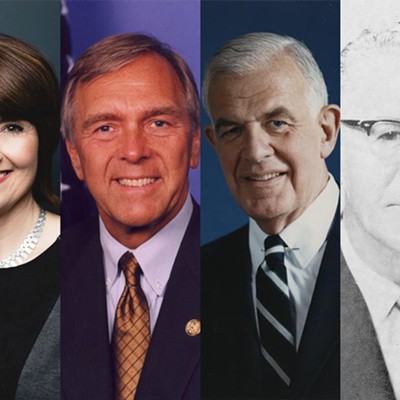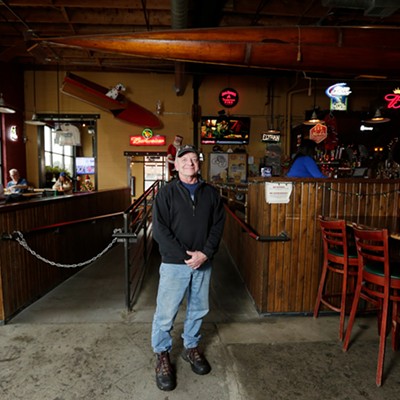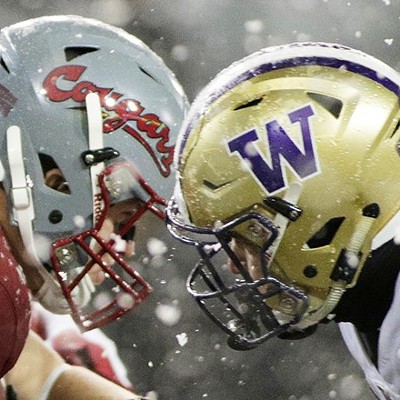Cutter in the White City
[
{
"name": "Broadstreet - Instory",
"insertPoint": "5",
"component": "25846487",
"requiredCountToDisplay": "5"
},{
"name": "Broadstreet - Instory",
"insertPoint": "10",
"component": "25846487",
"requiredCountToDisplay": "10"
},{
"name": "Broadstreet - Instory",
"insertPoint": "15",
"component": "25846487",
"requiredCountToDisplay": "15"
},{
"name": "Broadstreet - Instory",
"insertPoint": "20",
"component": "25846487",
"requiredCountToDisplay": "20"
}
]
by Ted S. McGregor, Jr.
The Chicago World's Columbian Exhibition of 1893 was like a beacon to the architects of the United States, attracting the best and brightest, and Spokane's own Kirtland Cutter was no exception. In his new book, The Devil and the White City, Erik Larson points out that more than 200 buildings covered the fairgrounds, erected by states, corporations and foreign governments.
In his biography, Kirtland Cutter: Architect in the Land of Promise, Henry Matthews devotes several pages to Cutter's contribution to the fair -- the Idaho State Building. Cutter won the commission for his eye for detail, which was apparent throughout. He exclusively used Idaho materials in its construction: Timber from Shoshone County, a giant shield of magnesia stone from Nez Perce County, lava rock from Logan County and huge sheets of mica from Latah County.
"Among the pretentious classical architecture of other state pavilions," writes Matthews, "the Idaho Building symbolized, in a romantic way, the virtues of nature against the competing forces of civilization."
Cutter and his partner John Poetz won the prize "for a type of architecture and construction which expresses the character of the state erecting it." Fair officials estimated that 10,000 people a day visited the chalet-inspired, three-story building, which featured an enormous stag's head above the entrance.
Larson says that in crossing the country on his current book tour, he has heard many stories of what happened to the buildings and smaller pieces of the fair. One Chicagoan who came to a reading said he saw an ornate old ticket booth in the backyard of a home he had considered buying. Some buildings were torched by arsonists; the Palace of Fine Arts was rebuilt as a permanent structure and remains the city's Museum of Science and Industry. What happened to the Idaho State Building is typical for its serendipitous fate.
Designed for easy transport, despite its 475 tons of timber, Cutter's structure was put up for auction after the fair ended. Captain Pabst, whose own brew won the coveted blue ribbon at the fair, wanted to move it to Milwaukee; another buyer wanted to drop it among the attractions at Coney Island. But a Chicago socialite bought it for $4,000 and had it moved to Lake Geneva, Wisc., as a summer lodge. It fell into disrepair, however, and was finally milled in 1911 for planking used to build a new pier on the lake.
An Englishman recently enriched who lost out in the bidding couldn't forget the building, however, and he hired Cutter to build him an exact replica among the trees of his estate in Hampshire. Cutter sent one of his key employees to England to oversee the construction. Failing to secure logs of the necessary size in Norway, the project required the shipment of Washington logs to England -- around the horn, no less.
Having a taste of the Wild West, the owner apparently wanted the real thing and soon moved to British Columbia. His estate was sold and Cutter's work appears to have been demolished within 10 years of the fair.
Publication date: 03/13/03
The Chicago World's Columbian Exhibition of 1893 was like a beacon to the architects of the United States, attracting the best and brightest, and Spokane's own Kirtland Cutter was no exception. In his new book, The Devil and the White City, Erik Larson points out that more than 200 buildings covered the fairgrounds, erected by states, corporations and foreign governments.
In his biography, Kirtland Cutter: Architect in the Land of Promise, Henry Matthews devotes several pages to Cutter's contribution to the fair -- the Idaho State Building. Cutter won the commission for his eye for detail, which was apparent throughout. He exclusively used Idaho materials in its construction: Timber from Shoshone County, a giant shield of magnesia stone from Nez Perce County, lava rock from Logan County and huge sheets of mica from Latah County.
"Among the pretentious classical architecture of other state pavilions," writes Matthews, "the Idaho Building symbolized, in a romantic way, the virtues of nature against the competing forces of civilization."
Cutter and his partner John Poetz won the prize "for a type of architecture and construction which expresses the character of the state erecting it." Fair officials estimated that 10,000 people a day visited the chalet-inspired, three-story building, which featured an enormous stag's head above the entrance.
Larson says that in crossing the country on his current book tour, he has heard many stories of what happened to the buildings and smaller pieces of the fair. One Chicagoan who came to a reading said he saw an ornate old ticket booth in the backyard of a home he had considered buying. Some buildings were torched by arsonists; the Palace of Fine Arts was rebuilt as a permanent structure and remains the city's Museum of Science and Industry. What happened to the Idaho State Building is typical for its serendipitous fate.
Designed for easy transport, despite its 475 tons of timber, Cutter's structure was put up for auction after the fair ended. Captain Pabst, whose own brew won the coveted blue ribbon at the fair, wanted to move it to Milwaukee; another buyer wanted to drop it among the attractions at Coney Island. But a Chicago socialite bought it for $4,000 and had it moved to Lake Geneva, Wisc., as a summer lodge. It fell into disrepair, however, and was finally milled in 1911 for planking used to build a new pier on the lake.
An Englishman recently enriched who lost out in the bidding couldn't forget the building, however, and he hired Cutter to build him an exact replica among the trees of his estate in Hampshire. Cutter sent one of his key employees to England to oversee the construction. Failing to secure logs of the necessary size in Norway, the project required the shipment of Washington logs to England -- around the horn, no less.
Having a taste of the Wild West, the owner apparently wanted the real thing and soon moved to British Columbia. His estate was sold and Cutter's work appears to have been demolished within 10 years of the fair.
Publication date: 03/13/03




















